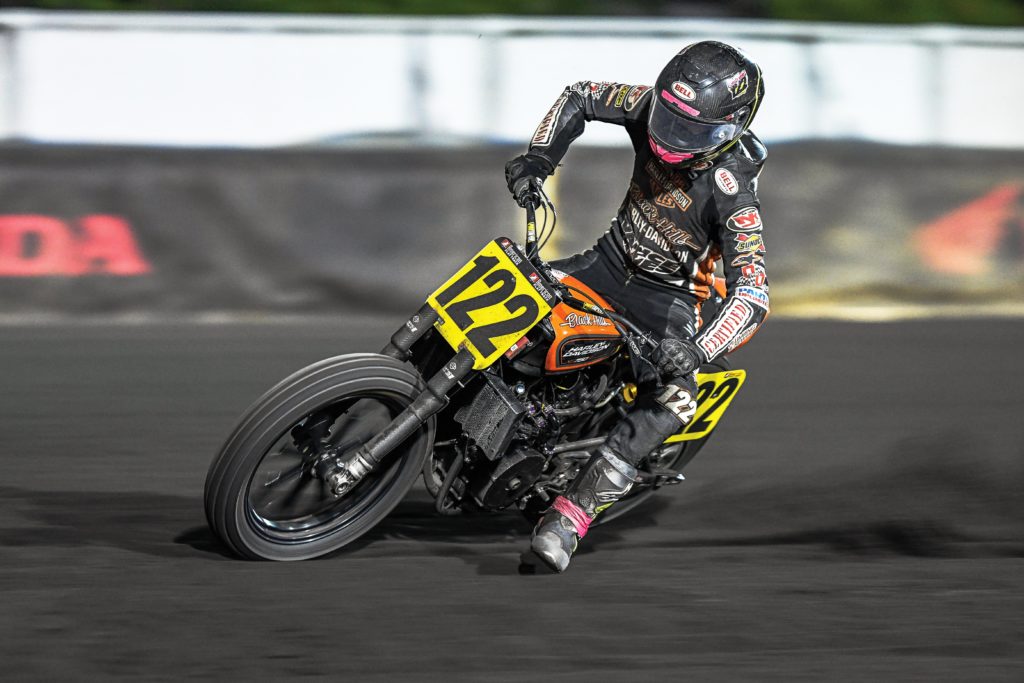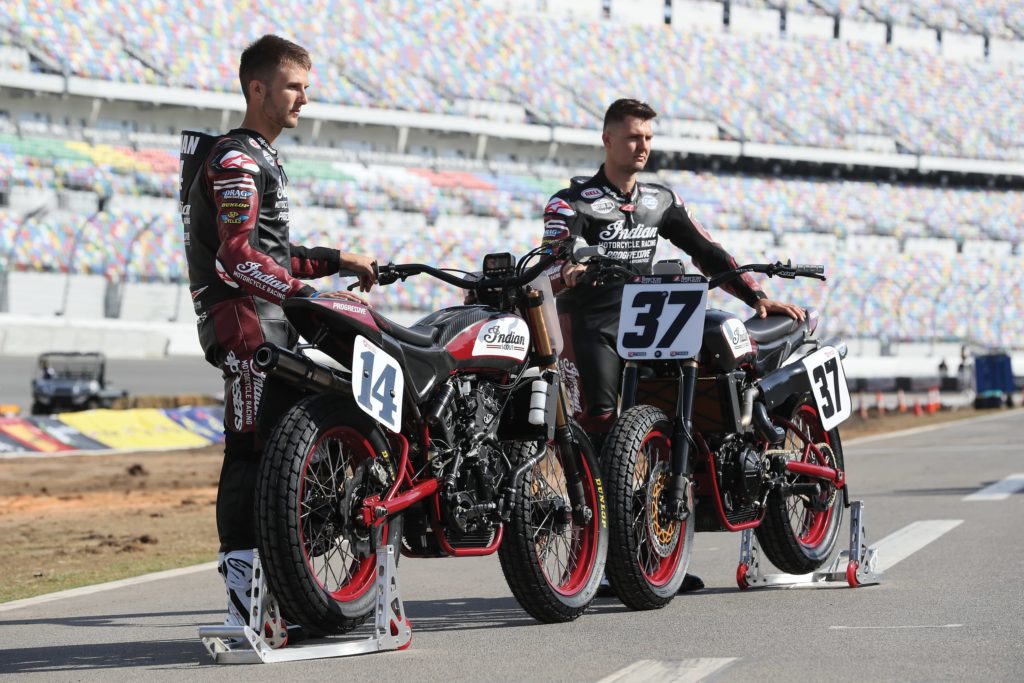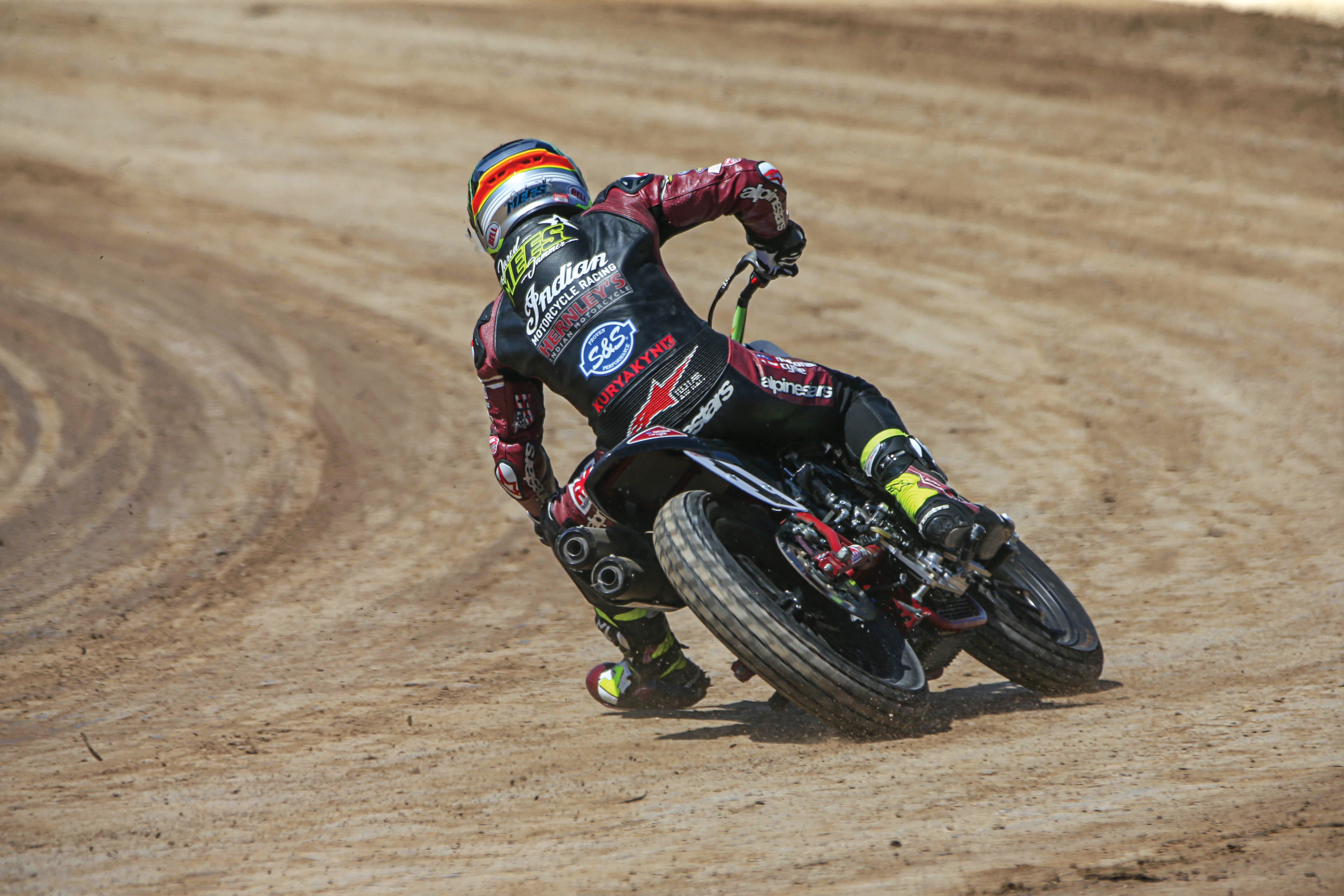
A behind-the-scenes look at the development of the first all-new dirt track race tire in nearly four decades – Dunlop’s DT4
Words by Mitch Boehm
Photos by Dunlop and Scott Hunter/AFT
Hard to believe, but it’s been decades since there was a wholesale redesign of the world’s most well-known dirt track tire, and the tire used on all racing motorcycles in American Flat Track competition: Dunlop’s DT3. The DT3 actually morphed from the Goodyear Eagle DT2, which itself came from the DT1, which began life as a roadracing rain tire and debuted in the late 1970s on dirt track machines ridden by guys with names like ‘King Kenny’ Roberts.
But with the introduction of the all-new Dunlop DT4, which takes over from the DT3 as the Official Tire of American Flat Track, that wholesale change has finally happened…and we have the inside scoop on its development.
Before digging into the details surrounding the DT4, consider for a moment the wide range of performance a top-shelf dirt track tire like the DT3 has had to offer over the years:

One tire has had to provide a high degree of traction, stability, feedback and durability on a wide range of motorcycles, from 300-plus-pound/100-horsepower twins to 200-plus-pound/60-horsepower singles. One tire has had to do this on a shockingly wide range of race tracks – ultra-fast Miles and Half-Miles, and medium- and slower-speed Short Tracks and TTs – with a dizzying array of surfaces and conditions: hard, soft, clay, pea gravel, loose cushion, bumpy, smooth, rocky, sandy, wet, dry and everything in between, including a little Tri-Oval asphalt at Daytona. One tire has had to do all this safely and without failure, over and over, weekend after weekend, year after year.
But after so many years and so many changes in the professional flat track world over the last handful of seasons, with new motorcycles, new rules, new technology and new racetracks, change was bound to come in AFT’s spec-tire formula… and now it has.

“Professional flat track racing in America has changed a lot over the last few years under Michael Lock’s leadership,” says Dunlop Senior Vice President Mike Buckley, a guy who’s helped manage Dunlop for nearly 30 years in the U.S., “and with all that change came the need for a new-generation tire for the series. In the twins class alone you’ve got new Harley-Davidson XG750Rs and Indian FTR750s, which are pretty different from the XR750s that’d been the staple for so many years. You’ve also got a bunch of Kawasakis and Yamahas in the mix now, and probably some all-new twins coming for 2020 or 2021 from other manufacturers. You’ve also got new racetracks on the circuit, some of which are pretty demanding and some that make it extremely difficult for one tire to cover, capability-wise. So yeah, it was time.”
Talk of the need for a new-generation Dunlop flat track tire dates to 2015, when Lock first joined AMA Pro Racing as a consultant, but discussions took on more urgency in late 2017 and early 2018, with Buckley and Lock – who became AFT’s CEO in 2016 – expanding the conversation to AFT’s competition department and Dunlop engineers. One of those Dunlop men was Lead Design Engineer Shawn Bell, who’d been with the company fifteen years and who’d been involved in the DT2-to-DT3 transition in 2014/’15.
“There was some interesting history to the DT project,” Bell told us. “When we transitioned from DT2 to DT3 several years ago we found some old mold drawings, hand-drawn stuff, which was really a blast from the past. Nowadays we use computerized 3D and auto-cad exclusively, but these original drawings were hand rendered! It showed us that the DT tires had some deep history, roots that connected what we were doing at the time to a lost era. Pretty cool stuff.”
Of course, 2016 and 2017 brought change in the form of new motorcycles from Harley-Davidson and Indian, new rules and new racetracks, all of which provided impetus for the next-gen tire.

“The sport was – and is – changing,” says Lock. “The bikes are faster and better. The riders are training year around, and things are super competitive in every class. And tires are an interesting and important part of the mix. The lack of brakes, the need for a high degree of feedback and the controlled loss of traction, etc. Our brief for the Dunlop folks wasn’t necessarily to make the bikes faster or to lower lap times, but to give riders more feedback and control so they can walk that fine line between traction and the loss of traction with more confidence – all of which leads to better racing and more excitement for riders, teams and our fans. Our plan all along was to introduce this new-generation tire for the 2020 season alongside our new AFT SuperTwins class, which would meld the best tires on the very best bikes being ridden by the world’s top riders. And that’s what’s going to happen this coming season.”
“When we sat down with the AFT folks,” says Buckley, “we knew right away we were on the same page. All we had to do was take an already good tire and improve it in every area. Simple, right? [Laughs.] But we knew that by bringing our technical might to the effort, we’d be able to do it. And looking at the result now, I believe we absolutely have.”
Buckley’s humorous sarcasm about improving an already good tire is by no means an exaggeration; just reading the list of goals is thoroughly daunting:
Improve grip via compounds, carcass construction and tread design. Improve feedback to rider. Improve cooling for high-speed, high-heat tracks. Improve durability. Improve straight-line stability. Improve start performance (less squirm). Improve production consistency (exact same tire for everyone). Improve cushion-track performance. Improve application friendliness (work well on more bike types). Improve safety. Improve compound breadth (two instead of three). And oh, yeah… and do all this for about the same price as the old tire. Easy, right?
The development process for the DT4 would be different; conservative in some ways, much like the DT3 remake, because Dunlop didn’t want to over-reach and end up with performance characteristics that did not fit the brief, yet radical in other ways to achieve goals listed above.
“So, yes, in many ways it’s an all-new tire,” says Buckley, “and in others not too far removed from what we had before. It was a balancing act, really. The old tire wasn’t broken, so why change things completely? We improved it where it needed improvement and kept the strong-performing elements.”
One of those strong-performing elements was the DT3’s carcass, the tire’s foundational structure, which was in large part carried over to the DT4.
“There’s a lot of new thinking in the DT4,” says engineer Bell, “but we wanted to keep some things constant, things that worked well – and the carcass design was one of them. It makes sense, really, because basically we used the DT3 as a benchmark, a place to start from and improve. The DT4 carcass is still a three-ply, bias design, not a radial, but there are a few changes, such as the ply structure and ply layout in the sidewall, which give it a bit more compliance there. Still, it’s pretty similar. The mold profile is basically the same as before, which means the tire itself, when mounted on a wheel, is almost identical in shape to the old tire. We did not want to disrupt the general feel of the bike with this new tire.
The list of totally new elements is significantly longer and includes the most obvious change – totally new tread patterns front and rear. The front DT4’s pattern bears some resemblance to the old tire, though there are only three grooves running circumferentially instead of five, with those grooves being straight instead of the DT3s mildly S-shaped ones. Dunlop says the grooves (and especially the arrow-straight centerline groove) help improve straight-line stability by not feeding any left- or right-directional forces into the chassis as the old tire did, which may have contributed to front-end head shake at speed. The shape of the tread blocks – and especially those on the tire’s shoulders – is different, as well, with the shoulder blocks having more leading-edge edge than before, which improves stability and grip while cornering.
The rear has similarly shaped (yet larger) tread blocks on each shoulder (which employ the leading-edge edge characteristics of the front), though the center of the tire is vastly different, employing uniquely-shaped center lugs that have been turned 90 degrees.
“Turning these blocks perpendicular adds more biting edge during starts and while transitioning from leaned over to straight up on corner exits,” says Bell. “They also have a lot of unique siping, which involved a lot of testing. At first the sipes were too deep and too numerous, which allowed too much tread-block flex and squirm, which allowed excessive heat and wear. But over time we got the balance between the number of sipes, their depth and their positioning just right. Back in the day, teams got pretty good at cutting their own customized sipes for use at particular racetracks. One pattern for cushion tracks, one for clay tracks, etc. It’s like that scene in On Any Sunday! That’s not allowed anymore, so we’ve sort of done it for them with the DT4.

Dunlop did a ton of testing on the new tires during 2018 and 2019 at a varied selection of racetracks and with a handful or top-level riders, including Jared Mees, Johnny Lewis, Shayna Texter, Dan Bromley, Sammy Halbert, Davis Fisher, James Rispoli, Hayden Gillam, JD Beach, Taylor Napp and others.
The DT4’s rubber compounds differ from those of the DT3, as well. Instead of the three compounds used previously, R5 (soft), R8 (medium) and R10 (hard), there will be only two, R5 and R9. The R5 is pretty much as before, a slightly softer tire for slower, less-abrasive tracks. The new R9 is a hybrid of sorts, a mixture of the old R8 and R10 compound characteristics, and a tire that can be run at a wide variety of Mile and Half-Mile venues. Thanks to clever compounding, the R9’s performance envelope is wide enough to allow it to be run at medium-speed, medium-abrasion tracks where the R8 was used previously, but also on high speed, high heat and high abrasion racetracks such as Springfield and Oklahoma City – where the R10 had been mandated for safety.
“Early on we tested the new compounds in existing [DT3] molds,” says Buckley, “and then moved to new [DT4] molds as we progressed in our development. Riders didn’t much like the R10,” says Buckley, “but we’re confident they’ll like the new R9 a lot more.
Finally, the DT4 is a tubeless design, though it can still be used with a tube on smaller displacement bikes without cast wheels. The benefits are less overheating, cooler running and improved puncture-resistance via the inner air liner/bladder. “Riders and techs can now better control tire pressures,” says Bell, “since you don’t have a tube sliding around and flexing and generating excessive heat inside the tire, especially when the big bikes run on the Mile tracks.
Riders who’ve tried the new tire are cautiously optimistic. “I did some testing early-on with the new compounds,” said multi-time Grand National Champion Jared Mees, “and liked what I felt. I did a 30-lap stint at speed on a Mile track and they felt good, really consistent.” Davis Fisher reported similar findings after an off-season test on the final version of the DT4. “I did a 25-lap Main Event simulation and posted my fastest time on the second-to-last lap,” he told us. “The tire never did go off, never got greasy, and that sort of consistency is a good thing.”
“We wanted to be state-of-the-art here,” says Buckley. “We wanted to bury that [tube-tire] dinosaur! Most teams are running cast wheels now, and those running spoke wheels on AFT Singles machines can still use a tube; no issues there. The safety issues, the cooler running… all good. And AFT was right with us there.”
AFT’s Michael Lock is certainly in agreement. “The 2020 season hasn’t started,” he says, “so we don’t really know how things will shake out. What I do know is that Dunlop has improved the tire in every area. If you can improve in all those areas on your first try, it’s a good effort – though it also means that maybe the old tire wasn’t as good as we all thought it was!”
“So yes,” Lock adds, “we are looking forward to the 2020 season, and we are very happy with Dunlop’s support of our series and its extensive R&D efforts here. The company has excellent engineering and testing facilities right here in the U.S. and a solid presence at the races, and if tweaks are needed they can handle it. Dunlop is helping us take American Flat Track to a new level, which fans will see in the coming year.”
It’s a partnership that’s resulted in the first all-new dirt track tire for professional competition in four decades, all of which means things are going to be extra interesting come the 2020 DAYTONA TT in March. See you there?


















[…] Check out Thunder Press’ coverage of Dunlop’s American Flat Track Tire HERE […]